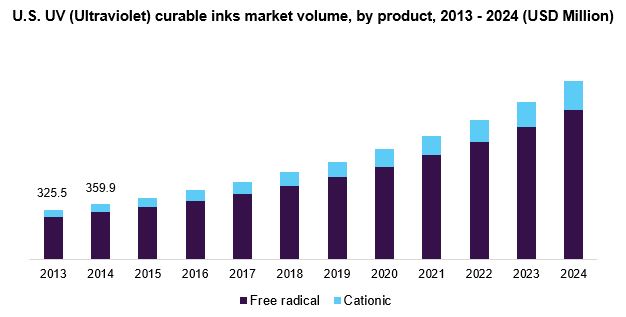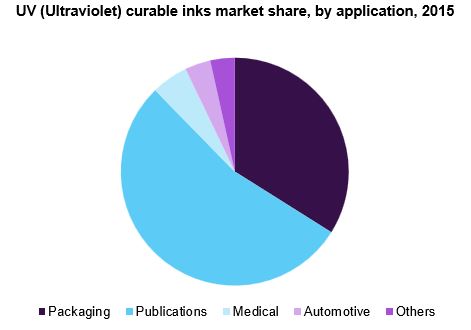- Home
- »
- Paints, Coatings & Printing Inks
- »
-
Ultraviolet Curable Inks Market Size & Share Report, 2018-2024GVR Report cover
![Ultraviolet Curable Inks Market Size, Share & Trends Report]()
Ultraviolet Curable Inks Market Size, Share & Trends Analysis Report By Product (Free Radical, Cationic), By Application (Automotive, Medical, Publications, Packaging), By Region, And Segment Forecasts, 2015 - 2024
- Report ID: 978-1-68038-947-0
- Number of Report Pages: 113
- Format: PDF, Horizon Databook
- Historical Data: 2013-2015
- Forecast Period: 2016 - 2024
- Industry: Bulk Chemicals
Industry Insights
The global Ultraviolet curable inks market size was USD 1.84 billion in 2015. Growing demand in multiple printing applications, on account of superior characteristics such as high bonding qualities, reduced drying time, and low volatile organic compound (VOC) content is expected to propel market growth. Technological advancements in the field have reduced the risk of fading, de-lamination, and bubble formations, which is anticipated to drive market demand. These inks possess low viscosity thereby reducing wastage by lower penetration into the printing materials. In addition, due to low viscosity, these may also be used for application on rigid surfaces, hence boosting the demand.
The market is likely to witness significant growth owing to its bio-compatible properties. Waste reduction, low pollutant emission, and low energy usage required for product manufacturing are expected to have a positive impact on market growth. Furthermore, increased printing throughput and higher productivity offered by ultraviolet-curable inks are anticipated to drive demand over the next eight years.

Growing demand for ultraviolet (UV) inks in 3D printing for automotive, consumer goods, and medical applications is expected to drive the market over the forecast period. Furthermore, high-performance characteristics, ease of applicability and low environmental impact as compared to other solvent-based inks are also anticipated to propel market growth.
Stringent regulatory framework by agencies such as the European Printing Ink Association and the Underwriter’s Laboratories are also likely to have a positive impact on industry growth. Various standards and certifications have also been implemented with regards to these inks, to provide consumer protection and reduce potential hazards.
Unique properties of UV curable inks and increasing awareness among printers are expected to augment the UV curable inks demand, globally. The growing adoption of UV curable inks on account of their high-performance efficiency, especially in the 3D printing sector coupled with low environmental impact is expected to drive the global market. Asia Pacific market is growing substantially as the adoption rate of UV inks in the region is high. The rising demand from developing economies such as China and India is expected to drive the market further.
Cationic polymerization is a newly introduced concept in the industry. The polymerization takes place through epoxy groups. Photoinitiators absorb UV light and generate Lewis acid. Cycloaliphatic epoxies are most commonly used as they react with Lewis acid efficiently to enable the polymerization. Furthermore, oxygen, high humidity, and basic materials do not inhibit cationic polymerization. In addition, raw materials required for cationic polymerization are less as compared to free radical polymerization.
The high initial costs and volatile raw material prices are expected to restrain market growth over the forecast period. High costs refer to expensive ultraviolet curing equipment and an array of anilox rolls that are required to adjust the print color. LED lamps also require air or water-cooling systems to control high temperatures generated by the curing process. This may also add to the cost of equipment and processing, which may pose a challenge to new market entrants.
Product Insights
Free radical inks were the largest product segment, accounting for over 90% of the market in 2015. The product obtained through this polymerization process requires less time and generates low temperatures that do not hinder the curing process. Furthermore, the process requires less energy as compared to its counterparts, which is likely to offer a competitive advantage for the product over the next eight years. Cationic polymerization is expected to witness significant growth in the market owing to low emission levels, non-odorous nature, and taint-free properties. Furthermore, humidity & oxygen resistance offered by this polymerization process which makes them ideal for flexible packaging applications is expected to drive demand over the forecast period.
Application Insights
The industry is segmented on the basis of application into automotive, medical, publications, packaging, and others such as plastics, electronics, and sports equipment. The publications and packaging segments dominated the market owing to the high demand for individualized and unique consumer goods, with attractive colors that are fostered by ultraviolet curable inks. The automotive application is likely to grow at a CAGR of over 10% from 2016 to 2024. The growing medical sector in developed & emerging economies, owing to the increasing geriatric population and rising consumer health awareness is also anticipated to boost product demand in this application.

Regional Insights
Asia Pacific emerged as the largest & fastest growing market in recent years, owing to the high demand for unique and environment-friendly inks in several applications. The region accounted for over 50% of the global UV curable inks market in 2015. The rapid expansion of end-use markets and rising consumer disposable income are other factors driving growth in this region. North America is anticipated to be a key region for UV curable inks market, owing to the presence of several electronic device manufacturers such as Micron, Intel, Texas Instruments, and Avago. These companies are actively engaged in the development of innovative digital and analog semiconductor technologies, which is likely to increase demand for UV curable inks over the forecast period.
UV (Ultraviolet) Curable Inks Market Insights
The UV curable inks market is highly competitive owing to the presence of a large number of established manufacturers and suppliers and new entrants in the market. Major players such as Hewlett-Packard Co., Flint Group, Toyo Ink SC Holdings Co., and Paul Leibinger GmbH are actively involved in the UV curable inks market, with numerous strategic alliances and product innovations, which are being emulated by other players as well.
Other market participants include APV Engineered Coatings, RUCO Druckfarben, Eastern Marking Machine Corporation, Gans Ink & Supply Co., T&K Toka Co. Ltd., Nutec Digital Ink Pvt. Ltd., Colorgen, Marabu Inks GB, Mimaki Engineering Co. Ltd., Nazdar Ink Technologies and Superior Printing Inks Co. Ltd.
Report Scope
Attribute
Details
Base year for estimation
2015
Actual estimates/Historical data
2013 - 2015
Forecast period
2016 - 2024
Market representation
Volume in Tons, Revenue in USD Million & CAGR from 2016 to 2024
Regional scope
North America, Europe, Asia Pacific, Latin America, Middle East & Africa
Country Scope
U.S., Germany, U.K., China, Japan, India, Brazil
Report coverage
Revenue forecast, competitive landscape, growth factors and trends
15% free customization scope (equivalent to 5 analyst working days)
If you need specific information, which is not currently within the scope of the report, we will provide it to you as a part of customization
Share this report with your colleague or friend.
![gvr icn]()
NEED A CUSTOM REPORT?
We can customize every report - free of charge - including purchasing stand-alone sections or country-level reports, as well as offer affordable discounts for start-ups & universities. Contact us now
![Certified Icon]()
We are GDPR and CCPA compliant! Your transaction & personal information is safe and secure. For more details, please read our privacy policy.
We are committed towards customer satisfaction, and quality service.
"The quality of research they have done for us has been excellent."





